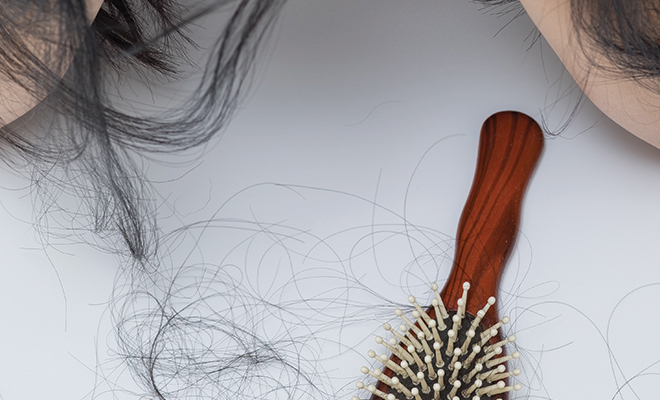
Help for hair loss
As a kid, I had no shame reflex when it came to laughing at my grandmother and her legendary thin, blue hair. She laughed about it, too! Frequently, she would take a wide-tooth comb out of her purse and ask me to fix her stiff hair in the back to, as she put it, “cover my bald spot.” We always got a chuckle out of this, as my efforts were usually in vain. She reluctantly attributed her thinning mane to the aging process and just threw a scarf over it most days.
While the afternoon of life seemed so far out in the distance to me then, I never put much thought into personally having an issue with hair loss until after the birth of my third child. Thanks to fluctuating hormones and all the other crazy stuff that goes on in our bodies as we grow a child, I began to notice my hair falling out, sometimes in clumps. I did not laugh; nor did I have a wide-tooth comb to put a bandage over the matter. To me, it was serious, and the only thing I could do was put a baseball cap on it and pray for a miracle.
Hair loss in women, while not uncommon, can be rather unsettling. However, it’s not just the hair at work here; what’s underneath is truly in control. What happens under the skin and in our bodies can interfere with a positive growth cycle. This could include medications, illness, infections and chemicals used on our hair. While we typically associate hair loss with men, women are just as likely to struggle with thinning hair. Typically, it occurs in one’s 50s and 60s, but some women notice it earlier in life. Unlike men, who typically present with a receding hair line when losing hair, women will notice thinning on the top third to one half of the scalp. Additionally, a part may gradually become wider or more of the scalp will be visible when the hair is pulled back.
Sometimes, hair loss can be attributed to heredity. According to the American Academy of Dermatology, a hereditary condition known as androgenetic alopecia is a hereditary form of hair loss and affects roughly 30 million American women; it is the most common cause of hair loss in women. Other conditions that can bring on hair loss include pregnancy, thyroid disorders, anemia, autoimmune diseases, polycystic ovary syndrome and certain skin conditions such as psoriasis and seborrheic dermatitis. Menopause is also a time when women may notice thinning hair, although that may or may not have a direct correlation, as menopause usually occurs at an age when women notice hair loss. Other contributing factors to hair loss include stress, physical trauma, surgery, illness and excessive intake of vitamin A. Further, frequent use of dyes, chemical treatments, blow dryers and flat irons can result in hair loss over time.
Treating hair loss is something to be discussed with your primary care physician or a dermatologist. There are numerous medications on the market designed to treat hair loss, but some physicians remain reluctant to prescribe them unless they know the hair loss is due to an excess of androgen in the system. As such, many physicians prescribe topical treatments. A thorough history and exam by your physician will allow you to know which medication is the right one for you.
Some home remedies may also prove effective in treating hair loss. Supplemental Vitamin B, also known as biotin, is vitally important to the growth and health of the hair. When you get adequate amounts of Vitamin B, you may often notice an increase in hair growth. Jojoba oil, used for more than a hundred years, has a powerful effect on hair growth when rubbed into the scalp and the hair. Saw Palmetto, which is known to block the formation of the hormone dihydrotestosterone that kills hair follicles, can dramatically improve hair health. Another remedy used for centuries is rosemary and is most effective when mixed with almond oil and applied directly to the scalp and hair loss area of concern. Emu oil, when applied to the scalp, simultaneously moisturizes and stimulates hair growth in the follicles.
Regular scalp massage helps to improve blood circulation and prevents hair loss. Simple steps such as changing your diet to include foods rich in vitamins and minerals will aid in hair growth. Bananas are rich in potassium and can significantly improve the circulation of blood at the scalp cells. Avoid crash diets, as those trigger hormonal imbalances and hair loss. Even depression, which can cause hormonal imbalance and hair loss, can be helped by meditation and aromatherapy in addition to prescribed medications.
It’s always advisable to speak with a medical professional about your hair loss concerns before initiating any type of treatment. Sometimes, it may take a combination of different approaches and the dedication to those treatments to notice improvement with your hair loss issues. HLM
Sources: aad.org, organicfacts.net and webmd.com.







